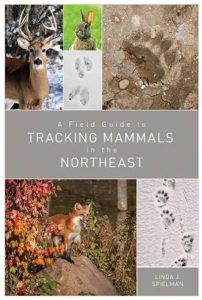 As more people come to value the natural world and venture into wildlife areas, a reference guide to help identify the animals who call these places home has never been more useful. A Field Guide to Tracking Mammals in the Northeast will be released July 4, 2017, from Countryman Press (W. W. Norton). I recently interviewed author Linda J. Spielman about how she came to write this forthcoming book.
As more people come to value the natural world and venture into wildlife areas, a reference guide to help identify the animals who call these places home has never been more useful. A Field Guide to Tracking Mammals in the Northeast will be released July 4, 2017, from Countryman Press (W. W. Norton). I recently interviewed author Linda J. Spielman about how she came to write this forthcoming book.
Jill Swenson: How did someone with a Ph.D. in plant pathology learn to track mammals?
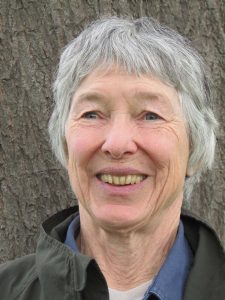 Linda Spielman: In a way, Plant Pathology was a temporary detour. As a child, I thought I wanted to be a forest ranger. But I learned some valuable things during my time in academia. I understand the scientific method and the conventions of scientific writing, and I’m accustomed to evaluating hypotheses using critical thinking. I also acquired a wealth of information about plant biology, microorganisms, and field natural history.
Linda Spielman: In a way, Plant Pathology was a temporary detour. As a child, I thought I wanted to be a forest ranger. But I learned some valuable things during my time in academia. I understand the scientific method and the conventions of scientific writing, and I’m accustomed to evaluating hypotheses using critical thinking. I also acquired a wealth of information about plant biology, microorganisms, and field natural history.
Animal tracking is a scientific undertaking. You may be familiar with Louis Leibenberg’s book, The Art of Tracking, The Origin of Science. Tracking works as a practical tool because trackers come to evidence-based conclusions. Serious trackers learn as much as they can about the physical and biological environment in which they track, and much of this knowledge is gathered from the scientific literature. My shift from plant pathology to natural history and then to animal tracking was driven by my need to follow my most passionate interest.
Jill Swenson: Is it easier to track in the winter than in the summer?
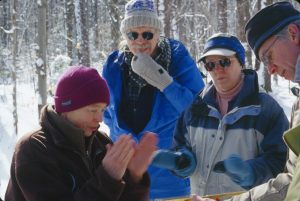 Linda Spielman: In some ways, yes. Here in the northeast, snow conditions are often so good tracks can be found almost anywhere. Snow allows us to follow trails with relative ease and for long enough distances that we can get wonderful insights into what animals actually do with their time. Without snow, finding tracks is harder and trailing them for any distance is impossible except for the most expert trackers. But if you know where to look, tracks can be found in any season, and tracks found in warm weather may have fine details lacking in snow prints.
Linda Spielman: In some ways, yes. Here in the northeast, snow conditions are often so good tracks can be found almost anywhere. Snow allows us to follow trails with relative ease and for long enough distances that we can get wonderful insights into what animals actually do with their time. Without snow, finding tracks is harder and trailing them for any distance is impossible except for the most expert trackers. But if you know where to look, tracks can be found in any season, and tracks found in warm weather may have fine details lacking in snow prints.
Jill Swenson: Do you teach others how to track mammals?
Linda Spielman: Tracking with other people is a wonderful way to expand one’s knowledge. I lead hands-on tracking workshops for participants at all levels. I also share my extensive collection of photographs in indoor slide presentations. I’ve worked with conservation organizations, tracking conferences, nature centers, college and university groups, and school-age youth. I also organize occasional tracking outings which are open to anyone. I always learn something from the questions people ask and the wide-ranging discussions we often get into.
Jill Swenson: What are the most important skills to learn in tracking?
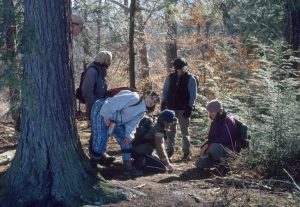 Linda Spielman: There are lots of critical technical skills—how to find tracks, measure and document tracks and gaits, understand gait patterns, know which gait patterns are associated with the various animal groups, and interpret pressure releases. But the most vital skills are related to attitude and mindset—slowing down, allowing one’s mind to become relaxed and open, observing both the tracks and their surroundings, looking from different angles (both physically and mentally), considering alternative hypotheses, and listening to one’s intuition.
Linda Spielman: There are lots of critical technical skills—how to find tracks, measure and document tracks and gaits, understand gait patterns, know which gait patterns are associated with the various animal groups, and interpret pressure releases. But the most vital skills are related to attitude and mindset—slowing down, allowing one’s mind to become relaxed and open, observing both the tracks and their surroundings, looking from different angles (both physically and mentally), considering alternative hypotheses, and listening to one’s intuition.
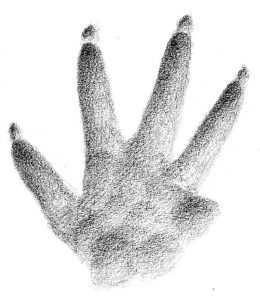 Jill Swenson: The images of tracks make your field guide quite different from others. Your illustrations show numerous track variations, and they are so detailed they look like photographs, but you drew them. Can you explain your creative process in producing this artwork?
Jill Swenson: The images of tracks make your field guide quite different from others. Your illustrations show numerous track variations, and they are so detailed they look like photographs, but you drew them. Can you explain your creative process in producing this artwork?
Linda Spielman: I’ve always been captivated by the beauty of animal tracks—they seem to express the life force of the animals who made them. I’ve been photographing tracks for nearly twenty years. The drawings in my book are realistic down to the smallest details, and to create them I studied photographs, measured and blocked out overall shapes, and added shading gradually to show depth and contours. I constantly rechecked to make sure the proportions were accurate and the balance and overall feel were right. At times, I became so immersed I felt like I became the track.
Jill Swenson: When I lived On Warren Pond Farm outside Ithaca, New York, there were many days when I wished I had a field guide like this. I took lots of photographs of wild critter prints in the snow and spent a lot of time trying to identify the specific visitors and nocturnal residents. I’m thrilled because readers will see specimen prints in situ instead of an idealized icon on the page. This is incredibly valuable for identification purposes. Once I have identified the animal who left a track, what else can the track tell me?
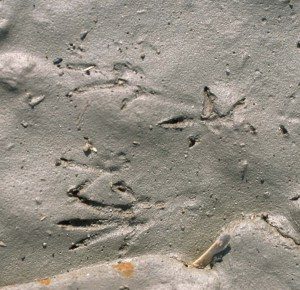 Linda Spielman: Track identification is only the beginning. Studying the whole sequence of tracks left by the animal tells us what direction it was headed, how fast it went, and what its mental attitude was. There may be subtle irregularities in the sequence that indicate a change in attitude, a pause, an interaction with another animal, or even an injury. Did the creature look to the side? Did it become alarmed or stop to investigate a possible food source? Did it carry something? Did it leave a mark or scent message for others of its species? Did it limp?
Linda Spielman: Track identification is only the beginning. Studying the whole sequence of tracks left by the animal tells us what direction it was headed, how fast it went, and what its mental attitude was. There may be subtle irregularities in the sequence that indicate a change in attitude, a pause, an interaction with another animal, or even an injury. Did the creature look to the side? Did it become alarmed or stop to investigate a possible food source? Did it carry something? Did it leave a mark or scent message for others of its species? Did it limp?
By studying the whole track sequence, we get a sense of a slice of the animal’s life. We can then begin to think about the animal in relation to the totality of its surroundings. Why was it following the particular route it took? Where might it have been going or coming from? When did it pass, and has it come this way before? What needs does the surrounding habitat satisfy?
Jill Swenson: What is the one animal that’s been the most elusive in your many years of tracking in the Northeast?
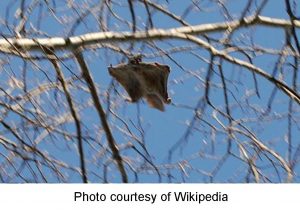 Linda Spielman: I’d have to say it’s the flying squirrel. They’re not uncommon, but they don’t spend much time on the ground—they prefer to get around by gliding from tree to tree. When they are on the ground—or on the snow, since snow offers the only genuine chance of seeing their tracks—reliable identification is difficult because their tracks are rarely well defined and their trails are often similar to the trails of other small rodents. The much talked about sitzmark, the body print made when a flying squirrel lands in the snow, is rarely found. Only after years of wandering in snowy forests and a few lucky discoveries did I start to accumulate direct knowledge of flying squirrel trails.
Linda Spielman: I’d have to say it’s the flying squirrel. They’re not uncommon, but they don’t spend much time on the ground—they prefer to get around by gliding from tree to tree. When they are on the ground—or on the snow, since snow offers the only genuine chance of seeing their tracks—reliable identification is difficult because their tracks are rarely well defined and their trails are often similar to the trails of other small rodents. The much talked about sitzmark, the body print made when a flying squirrel lands in the snow, is rarely found. Only after years of wandering in snowy forests and a few lucky discoveries did I start to accumulate direct knowledge of flying squirrel trails.
Jill Swenson: Who will use your field guide and is it a teaching tool?
Linda Spielman: Anyone interested in mammals or animal tracking will find my book helpful. Those new to tracking will find advice for getting started as well as complete information for identifying both animal groups and species within groups. For more experienced trackers, the emphasis on track and gait variations will encourage new ways of looking at tracks and might help to solve those pesky tracking mysteries every tracker accumulates. Trackers outside the northeastern United States will find the kinds of variation documented in my book also occur in different animals and in other regions.
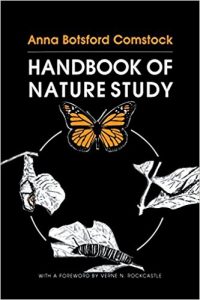 Jill Swenson: Anna Botsford Comstock’s Handbook of Nature Study is one of my favorite books. First published in 1911, it became a standard textbook for teachers, translated into eight languages, more than twenty printings. Cornell University Press continues to print and sell copies of it. Your connections to Cornell University are strong and you plan to have a book launch event at the Cornell University Botanic Gardens on July 16. What books did you read as a young person that influenced your thinking most in this direction toward tracking?
Jill Swenson: Anna Botsford Comstock’s Handbook of Nature Study is one of my favorite books. First published in 1911, it became a standard textbook for teachers, translated into eight languages, more than twenty printings. Cornell University Press continues to print and sell copies of it. Your connections to Cornell University are strong and you plan to have a book launch event at the Cornell University Botanic Gardens on July 16. What books did you read as a young person that influenced your thinking most in this direction toward tracking?
Linda Spielman: I still have vivid memories of Jack London’s Call of the Wild, and Rudyard Kipling’s Toomai of the Elephants. I loved Misty of Chincoteague by Marguerite Henry. Short story collections by Ernest Thompson Seton, especially Wild Animals I Have Known, fed my imagination, and I immersed myself in Henry David Thoreau’s descriptions of wilderness in The Maine Woods. To learn the names and habits of wild things, I relied on the Peterson Field Guide to Eastern Birds, Newcomb’s Wildflower Guide by Lawrence Newcomb, and the Illustrated Guide to Trees and Shrubs by Arthur H. Graves. The Fieldbook of Natural History by Palmer and Fowler was a wonderful resource, and I treasured a book called Woodcraft by George W. Sears.
Jill Swenson: You’re a rather private and quiet person. This strikes me as necessary if you track mammals. But it also suggests there are some benefits of solitude in the wild within a different mindset than the everyday rush-rush of digital life. What lessons from tracking have made your life better?
Linda Spielman: Spending time outside in wild places has always been important to me, and being able to read nature’s messages through animal tracking has made my experiences more intense and meaningful. I’ve learned to value the time I spend in nature, and to appreciate how important exposure to nature is for human well-being. Animal tracking has also taught me specific life lessons: to be more patient, to consider incoming information even if it doesn’t fit with my preconceptions, to be a better observer, and to trust my intuition.
Every tracker makes mistakes—in fact, growth requires this—and I’ve learned to be humble and to recognize my own limitations. I’ve also become a better communicator and more comfortable with people.
Jill Swenson: Social media strategy is important for an author, but engaging with your audience isn’t always online. You’re not on Facebook or Twitter. This is a conscious strategy and it allowed you to finish your manuscript and submit it for production to your publisher, as well as continue to spend lots of time outside. You do have a professional profile on LinkedIn and a website. And you built the site yourself. You are authentically off-the-grid most of the time in remote places where internet access is spotty at best. The target audience will buy this book because it is a book. And it’s small enough to carry into the field.
Tell us, how people can contact you, learn more, and pre-order the book. Where will you be teaching? Upcoming conferences or workshops? And whether you will be leading any tracking adventures this spring.
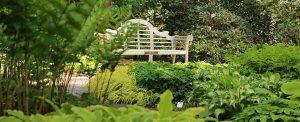 Linda Spielman: The official launch for my book will be on July 16 at Cornell Botanic Gardens from 2-4 pm. I’ll be doing a presentation at the Northeast Wildlife Trackers Conference in Massachusetts in October. I’ll also be scheduling tracking outings—open to all—in the Ithaca area periodically through the spring and summer. If you visit my website, www.lindajspielman.com, you’ll find information on all my upcoming workshops and events. You can also contact me by email at lindajspielman@gmail.com. My book can be pre-ordered on Amazon.
Linda Spielman: The official launch for my book will be on July 16 at Cornell Botanic Gardens from 2-4 pm. I’ll be doing a presentation at the Northeast Wildlife Trackers Conference in Massachusetts in October. I’ll also be scheduling tracking outings—open to all—in the Ithaca area periodically through the spring and summer. If you visit my website, www.lindajspielman.com, you’ll find information on all my upcoming workshops and events. You can also contact me by email at lindajspielman@gmail.com. My book can be pre-ordered on Amazon.
